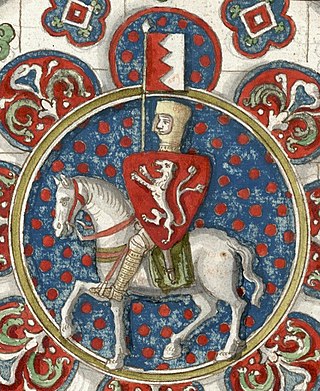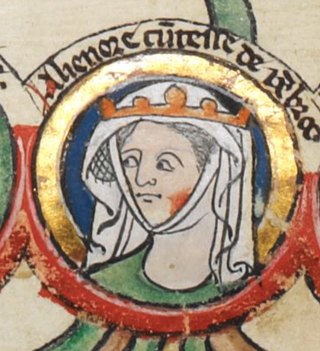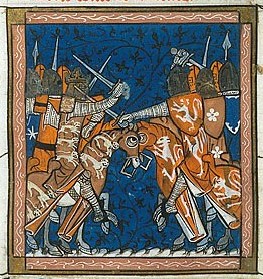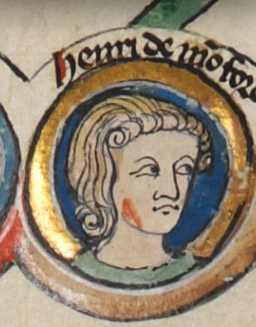
Llywelyn ap Gruffudd, Llywelyn II, also known as Llywelyn the Last, was King of Gwynedd, and later was recognised as the prince of Wales from 1258 until his death at Cilmeri in 1282. Llywelyn was the son of Gruffudd ap Llywelyn ap Iorwerth and grandson of Llywelyn ab Iorwerth, and he was one of the last native and independent princes of Wales before its conquest by Edward I of England and English rule in Wales that followed, until Owain Glyndŵr held the title during the Welsh Revolt of 1400–1415.

Simon de Montfort, 6th Earl of Leicester, later sometimes referred to as Simon V de Montfort to distinguish him from his namesake relatives, was an English nobleman of French origin and a member of the English peerage, who led the baronial opposition to the rule of King Henry III of England, culminating in the Second Barons' War. Following his initial victories over royal forces, he became de facto ruler of the country, and played a major role in the constitutional development of England.
The Battle of Evesham was one of the two main battles of 13th century England's Second Barons' War. It marked the defeat of Simon de Montfort, Earl of Leicester, and the rebellious barons by the future King Edward I, who led the forces of his father, King Henry III. It took place on 4 August 1265, near the town of Evesham, Worcestershire.

Eleanor de Montfort, Princess of Wales and Lady of Snowdon was an English noble and Welsh Princess. She was the daughter of Simon de Montfort, 6th Earl of Leicester and Eleanor of England. She was also the second woman who can be shown to have used the title Princess of Wales.

Roger Mortimer, 1st Baron Mortimer of Wigmore, of Wigmore Castle in Herefordshire, was a marcher lord who was a loyal ally of King Henry III of England and at times an enemy, at times an ally, of Llywelyn ap Gruffudd, Prince of Wales.

Eleanor of England was the youngest child of John, King of England and Isabella of Angoulême.
This article presents a timeline of events in British history from 1000 AD until 1499 AD.

The Treaty of Montgomery was an Anglo-Welsh treaty signed on 29 September 1267 in Montgomeryshire by which Llywelyn ap Gruffudd was acknowledged as Prince of Wales by King Henry III of England. It was the only time an English ruler recognised the right of a ruler of Gwynedd over Wales. Llywelyn's grandfather Llywelyn the Great had previously laid claim to be the effective prince of Wales by using the title "Prince of Aberffraw, Lord of Snowdon" in the 1230s, after subduing all the other Welsh dynasties. Likewise Llywelyn's uncle, Dafydd ap Llywelyn, claimed the title of Prince of Wales during his reign from 1240 to 1246. However, Llywelyn's supremacy in the late 1260s forced recognition of his authority in Wales by an English Crown weakened by internal division.

The Second Barons' War (1264–1267) was a civil war in England between the forces of a number of barons led by Simon de Montfort against the royalist forces of King Henry III, led initially by the king himself and later by his son, the future King Edward I. The barons sought to force the king to rule with a council of barons, rather than through his favourites. The war also involved a series of massacres of Jews by de Montfort's supporters, including his sons Henry and Simon, in attacks aimed at seizing and destroying evidence of baronial debts. To bolster the initial success of his baronial regime, de Montfort sought to broaden the social foundations of parliament by extending the franchise to the commons for the first time. However, after a rule of just over a year, de Montfort was killed by forces loyal to the king at the Battle of Evesham.

Sir Henry de Montfort was the son of Simon de Montfort, 6th Earl of Leicester, and with his father played an important role in the struggle of the barons against King Henry III. Henry's mother was Princess Eleanor of England, a daughter of King John, whose marriage to Simon further increased the foreign influence begun by the king, which was to result in great hostility by those very barons who later revolted against the king.

The Principality of Wales was originally the territory of the native Welsh princes of the House of Aberffraw from 1216 to 1283, encompassing two-thirds of modern Wales during its height of 1267–1277. Following the conquest of Wales by Edward I of England of 1277 to 1283, those parts of Wales retained under the direct control of the English crown, principally in the north and west of the country, were re-constituted as a new Principality of Wales and ruled either by the monarch or the monarch's heir though not formally incorporated into the Kingdom of England. This was ultimately accomplished with the Laws in Wales Acts 1535–1542 when the Principality ceased to exist as a separate entity.

Amaury de Montfort was the third son of parliamentary pioneer Simon de Montfort, 6th Earl of Leicester, and Eleanor of England, daughter of King John.

The Treaty of Aberconwy was signed on the 10th of November 1277, and was made between King Edward I of England and Llywelyn ap Gruffudd, Prince of Wales. It followed Edward's invasion of Llywelyn's territories earlier that year. The treaty re-established peace between the two but also essentially guaranteed that Welsh self-rule would end upon Llywelyn's death and represented the completion of the first stage of the Conquest of Wales by Edward I.

Madog II was a Prince of Powys Fadog from 1269 to 1277. He supported the Prince of Wales, Llywelyn ap Gruffudd, who had married the daughter of Simon de Montfort, 6th Earl of Leicester.
This article is about the particular significance of the century 1201–1300 to Wales and its people.
Events from the 1260s in England.
Events from the 1240s in England.

Wales in the High Middle Ages covers the 11th to 13th centuries in Welsh history. Beginning shortly before the Norman invasion of the 1060s and ending with the Conquest of Wales by Edward I between 1278 and 1283, it was a period of significant political, cultural and social change for the country.
Pipton is a small settlement and former civil parish in Powys, Wales on the Afon Llynfi near its confluence with the River Wye. It was formerly in the county of Brecknockshire and is now part of the community of Bronllys. The nearest town is Hay-on-Wye some 5 miles (8.0 km) to the east.

Y Gorddwr was a medieval commote in the cantref of Ystlyg in the Kingdom of Powys. It was on the eastern side of the River Severn bordering England, on the west it was bordered by two of the other commotes of Ystlyg - Deuddwr in the north and Ystrad Marchell in the south. Its Welsh name could mean "the upper water"; gor- "upper-", dŵr "water".












